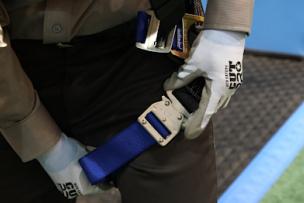The need to tether tools is real. On average, a tool or other object falls on a worker every 10 minutes, seven days a week.
Fall protection is not just about keeping workers safe from potential slips, trips and falls. You also must provide safety gear and establish practices to protect workers from tools and objects that could fall on them.
Every year, according to the Bureau of Labor Statistics, more than 50,000 people are struck by objects on the job. Contact with objects is the No. 2 most common nonfatal injury resulting in days away from work, 25 years of BLS data shows.
Given incident reporting to the Occupational Safety and Health Administration that a “struck by” accident happens 143 times a day every day of the week, 3M estimates that a worker is injured every 10 minutes by a dropped object.
These incidents turn fatal hundreds of times a year because of the gravity effect. “An eight-pound wrench dropped 200 feet would hit with a force of 2,833 pounds per square inch—the equivalent of a small car hitting a one-square-inch area,” notes Mark Caldwell, former director of fall protection tools for 3M, in EHS Today.
"We call it the three 'Ps': People, productivity, property," says Tomi Jacobson, a fall protection tool marketing manager for 3M, in a recent "Stop the Drop" webinar hosted on Better MRO. "Dropped objects are the third cause of deaths on the job after transportation and falls. It can cause a work stoppage. In some cases, it can be the cause of some very costly situations. For example, in the nuclear industry, tools dropped in the wrong vat can cause major damage."
Tool Tethering: Dropped Object Prevention Goes Beyond Construction
While reported “struck by object” incidents are among the fatal four concerns in construction, according to OSHA data, it’s an area of concern for manufacturing and metalworking environments as well, where large equipment and tools are prevalent.
Tethering tools to workers and to guardrail systems is one of the most effective ways to prevent falling object injuries. The use of tethers for tools and training employees about when and how to use them protects not only the health of your team but also the business’s bottom line.
While OSHA 1910.28 requires that businesses protect employees from exposure to falling object hazards, there is no OSHA standard that requires tethers. But last year, the voluntary ANSI/ISEA 121 standard took effect; it provides guidance and details performance criteria for tool and equipment tethering products.
It’s also good to know what 121 doesn’t cover: It doesn’t specify proper use of equipment for workers or specify what needs to be tethered and when it needs to be tethered.
Instead, each tether manufacturer specifies the use of its equipment, points out Ergodyne, which like 3M took part in developing the voluntary standard. And every business using tethers is responsible for specifying when its workers need to tether and what they need to tether.
Need help with fall protection or other compliance-based training? Get an instant quote from the Center for Safety and Environmental Management and MSC.



Talk to Us!
Hello! thank you so much for your article! I was wondering whats the reference for #3 of your guidelines? "
#3: Is the tool heavy—more than 5 pounds?
Tools that weigh more than 5 pounds should be tethered to a fixed structure or an anchor point, not a worker."
I've been trying to look through standards and regulations to find the appropriate load limit to attach to a person, but haven't found anything yet. Where did you get 5lbs from? Thank you so much for your help! Cheers!
55Aimie, thank you for your question regarding this topic.
Since this standard is still just an ANSI standard and not officially adopted by OSHA at this point there is nothing in the standard specific to the maximum weight of a tool being tethered to the body.
3M uses the 5-pound maximum as a best practice to prevent injury to the person from either loss of balance or the weight of the tool during the fall dislocating a shoulder or other body part.
Again, the is primarily a good rule of thumb.
As the article notes that even though this is not an official OSHA standard for Tool Tethering, OSHA does require employers to address falling/dropped objects hazards on the job. They mention this both in General Industry (1910.23; 1910.28) and Construction (1926.451; 1926.501; 1926.759) standards. This establishes that OSHA does require mitigation of falling/dropped objects risk.
This could also be cited under the "General Duty Clause"
OSH Act of 1970 SEC.5
Duties
(a) Each employer --
(1) shall furnish to each of his employees employment and a place of employment which are free from recognized hazards that are causing or are likely to cause death or serious physical harm to his employees;
Please feel free to reach out if you have other questions.
Paul Cook
MSC Safety Specialist
37Leave a reply
Your email address will not be published. Required fields are marked *